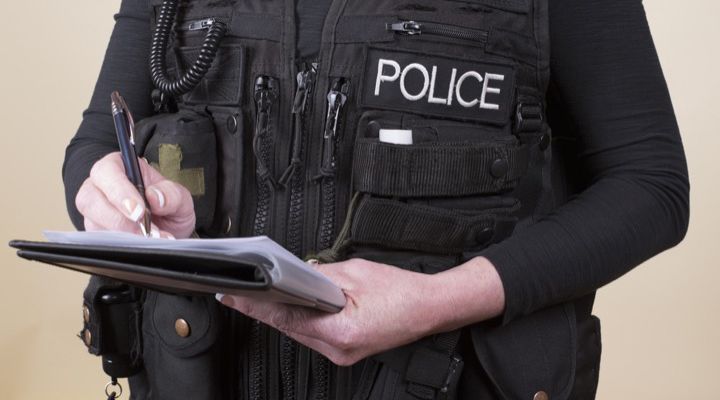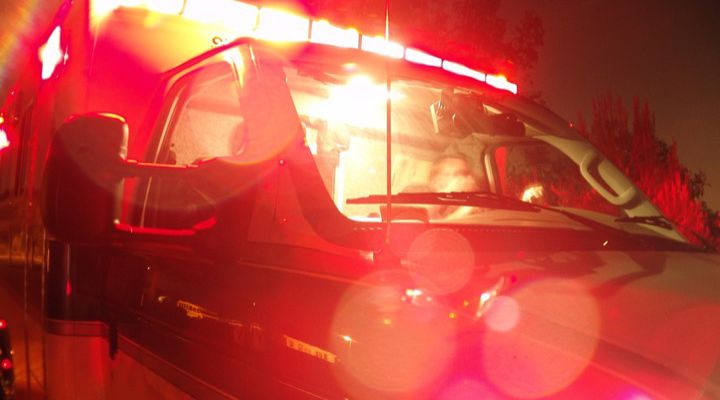VIDEO :
On a cool Saturday evening in Lolo Hot Springs, Montana—a small, quiet community set against the rugged wilderness of the Lolo National Forest—a routine police call turned into a story that would grip the hearts of everyone who heard it. That night, as the stars began to twinkle over a landscape known more for its serene beauty than its troubles, a disturbance call shattered the calm. Deputies from the Missoula County Sheriff’s Office raced toward reports of a local man causing a commotion in public, unaware that this call would soon evolve into a desperate search for a missing baby.
The caller’s voice was filled with urgency, describing a man acting erratically and threatening those nearby, even hinting at the possibility of a gun. The man in question was Francis Crowley, a local resident known for living in a makeshift camp near the hot springs in Lolo National Forest. Though many knew Francis for his troubled lifestyle and bouts of instability, no one could have predicted that he was also responsible for the care of a 5‐month-old baby—a baby who was now unaccounted for. As the deputies sped toward the scene, the initial report of a public disturbance grew even more alarming when additional 911 calls mentioned that the baby, who had been in Francis’s care while a nearby woman worked, had vanished without a trace.
When the officers arrived, they found a scene of confusion and disarray. Witnesses described how Francis had been seen earlier with the infant, a symbol of hope in an otherwise troubled life, but now that tiny presence had inexplicably disappeared. The officers learned that Francis had been in a state of agitation, likely under the influence of drugs, and his behavior had only worsened as the night progressed. After a brief disappearance from the scene, he reappeared, disoriented and incoherent. His wild, conflicting statements did little to clarify the situation. One moment, he insisted that he had left the baby alive by the roadside after a car crash; the next, he suggested the child had died in the accident or, shockingly, had been buried in the woods.
With time rapidly slipping away, the deputies knew they had to act quickly. Every passing minute was critical in the search for the helpless infant. A large-scale search and rescue operation was launched immediately. Missoula County Sheriff’s Deputies joined forces with U.S. Forest Service Law Enforcement Officers, combing through the dense and unforgiving terrain of the Montana wilderness. The officers were guided by the few, vague descriptions that Francis had provided about the location of his car crash—a description that varied with every retelling, muddled by his drug-induced state.
Deputy Ross Jessop and U.S. Forest Officer Nick Scholz led a determined team along an abandoned road that matched one of the descriptions given by Francis. Their efforts were tireless, each step driven by the hope of finding the missing child. The search was fraught with challenges. The remote roads, overgrown with the wild brush of the forest, and the dim light of a moonless night made every twist and turn unpredictable. The officers encountered a series of clues along the way: a scattering of children’s trivia cards, a container of baby formula, and a piece of baby clothing caught in a bush. Further down the slope, an abandoned diaper bag and a baby carriage hinted at a hurried departure, a desperate attempt to rid the scene of evidence.
At one point, the team’s determination seemed to wane as the hours stretched on with no sign of the child. By nearly 2:00 a.m., hope was fading and the grim possibility of a tragedy loomed large. Deputy Jessop admitted that he had prepared himself for the worst—that he might find the baby lifeless, abandoned in the unforgiving wilderness. The heavy silence of the forest was punctuated only by the sound of officers’ footsteps and their anxious whispers as they scoured every inch of the area.
Then, as if fate had decided to intervene, a faint sound broke through the darkness—a soft, nearly imperceptible whimper that immediately caught the attention of Deputy Jessop and Officer Scholz. The sound was the quiet cry of a baby, so weak it almost blended into the natural nighttime symphony of rustling leaves and distant animal calls. Instantly, every weary step was replaced by a burst of energy and determination. The two officers exchanged a look that said, without words, that they could not let this chance slip away. They sprinted toward the source of that fragile sound, their hearts pounding with anticipation.
As they hurried up a steep, rugged incline, a sudden snap—a broken twig underfoot—alerted Deputy Jessop to slow down for just a moment. Looking down, his eyes widened at the sight before him. There, partially hidden beneath a disorganized pile of damp sticks and leaves, lay a small, shivering 5‐month-old baby. The child was cold, dirty, and clearly had been through a harrowing ordeal, but against all odds, his tiny chest still rose and fell with the steady rhythm of life. In that split second, every moment of the search, every anxious hour spent combing through the wilderness, culminated in this singular, miraculous discovery.
Without a second thought or any regard for protocol, Deputy Jessop gently scooped the baby into his arms. In that tender moment, all that mattered was the life he held, fragile and yet full of the promise of survival. With the baby cradled close to his chest, Jessop checked for signs of breathing and warmth, murmuring soft reassurances to the little one as if promising a better future. There was no time for hesitation; every second counted, and the journey to safety had to be swift and sure.
The trek from that cold, isolated spot in the forest to the safety of an awaiting ambulance was tense and fraught with peril. Every step along the rugged path was a race against time and the creeping chill of the Montana night. Yet, the baby’s presence, fragile as it was, provided the team with renewed vigor. Along the twenty-minute walk to the ambulance, the little one began to show signs of distress—a few coughs that expelled tiny fragments of sticks and leaves from his mouth, reminders of the harsh environment he had endured. Still, he clutched onto life with a strength that belied his tender age, a silent testimony to the resilience of the human spirit.
Once the team reached the ambulance, the transition from rescue to urgent medical care was immediate. Paramedics took over with practiced efficiency, hooking the baby up to an IV and warming him with blankets. The scene inside the ambulance was one of rapid, coordinated effort; every movement was precise and filled with the hope of saving a life. Sheriff Captain Bill Burt, who was overseeing the operation, later recalled how, in the midst of this frantic rush, the baby displayed a remarkable burst of energy. As soon as the child was offered a bottle of Pedialyte, he drank it in under a minute—then went on to finish two more bottles during the ride to the hospital. That tiny, determined grip on Captain Burt’s finger was a powerful symbol of survival, a small hand that had clung to hope even in the darkest moments.
At the hospital, doctors and nurses continued their rapid response, stabilizing the baby and monitoring his condition with a careful, almost reverent diligence. The overwhelming relief that swept through the medical team was mirrored by the emotions of everyone involved in the search. The miraculous recovery of the child, against all the odds, was a moment of victory—a shining beacon of hope in what had been a night shadowed by despair and uncertainty.
As dawn broke over the Montana horizon, casting gentle light over the recovering baby and the exhausted yet elated rescue team, the community slowly began to process the events of the night. Francis Crowley, the man whose erratic behavior had inadvertently set off the chain of events, was taken into custody. His multiple, conflicting statements about what had happened to the baby were recorded and would later form the basis of charges against him, including criminal endangerment and assault on a minor. In court, Crowley’s emotional breakdowns—marked by tearful declarations and repeated cries of love for the child—painted a tragic picture of a man torn between his own inner demons and a misplaced sense of responsibility.
For the people of Lolo Hot Springs, the rescue of the missing baby became a story recounted over and over—a tale of a community united by the bond of hope and the power of human kindness. Neighbors gathered to discuss the events, their voices filled with relief and gratitude for the heroic actions of Deputy Ross Jessop, Officer Nick Scholz, and all those who had worked through the night to bring the baby to safety. In local coffee shops, at family dinners, and in quiet conversations on porches, the story was told not as a tragic failure, but as a miraculous turnaround—a reminder that even in the bleakest circumstances, a spark of life can ignite an outpouring of compassion.
Listeners and viewers who heard this story found themselves drawn into the unfolding drama, feeling every moment of tension, every heartbeat of hope as the rescuers pressed on through the night. The narrative was simple yet profound: a night that began with chaos and uncertainty transformed into a powerful testament to the resilience of the human spirit. It was a reminder that no matter how dire the circumstances, there is always a chance for redemption, always a moment when hope prevails over despair.
In the days that followed, the story continued to resonate deeply with everyone who encountered it. Local news outlets carried the tale far beyond the borders of Lolo Hot Springs, and soon, the miraculous rescue became a beacon of inspiration across the region. Interviews with the officers and paramedics who had taken part in the rescue painted a picture of dedication and courage—a reminder that in every community, there are those willing to risk everything to protect the vulnerable. Families spoke of the baby’s tiny, determined hands and the way his soft, quiet cries had awakened something deep within all who heard him. It was as if that small cry had the power to cut through the hardest hearts, to remind everyone of the value of life and the importance of caring for one another.
The story of that night in Lolo Hot Springs soon became more than just a headline—it became a living narrative shared by a community that had witnessed a miracle. Neighbors organized meetings to support better mental health resources and substance abuse programs, recognizing that the tragedy behind the rescue was rooted in larger, systemic issues that needed to be addressed. At the same time, local law enforcement was praised for their swift response and unwavering commitment to the welfare of every citizen, no matter how challenging the circumstances. The rescue of the baby was celebrated not only as a successful operation but as a profound act of humanity—a shining example of what can be achieved when compassion guides every action.
For those who listened to or watched the recounting of this story, the impact was clear: the narrative was not about the failures or the missteps along the way, but about the incredible power of hope and the strength of the human heart. In every retelling, there was a reminder that sometimes, the smallest cry can spark the greatest response; that in the darkest hours, a single act of kindness can transform despair into triumph. The baby’s survival was a victory for the entire community—a victory that underscored the importance of vigilance, of community spirit, and of the unyielding belief that every life matters.
As the months passed and the community of Lolo Hot Springs began to heal, the story continued to be shared at local gatherings, on community bulletin boards, and through social media channels. It was a story that resonated with anyone who had ever felt the weight of uncertainty or the sting of loss, and it served as a constant reminder that hope can be found even in the most unexpected places. The baby, once lost in the vast wilderness of Montana, became a symbol of resilience and the transformative power of collective care—a living testament to the fact that no one is ever truly lost when a community comes together.
In the end, the night that began with chaos and fear was remembered for the incredible courage and compassion it inspired. Listeners and viewers were left with a story that was both heart-wrenching and uplifting—a story that encapsulated the unpredictable twists of fate and the boundless capacity of human empathy. It was a reminder that even in a world filled with uncertainty, there is always light to be found, always hope to be cherished, and always a reason to believe in the possibility of miracles.
For those who continue to tell this story, the rescue in Lolo Hot Springs stands as a beacon of hope and a call to action—a call to protect the innocent, to support those in need, and to always listen for the faintest cry that may signal a life in peril. The narrative is simple, yet its impact is profound: in every whisper of the wind through the trees, in every rustle of leaves on a cold night, there lies the promise that hope, once sparked, can shine brighter than the darkest of nights.













0 commentaires: